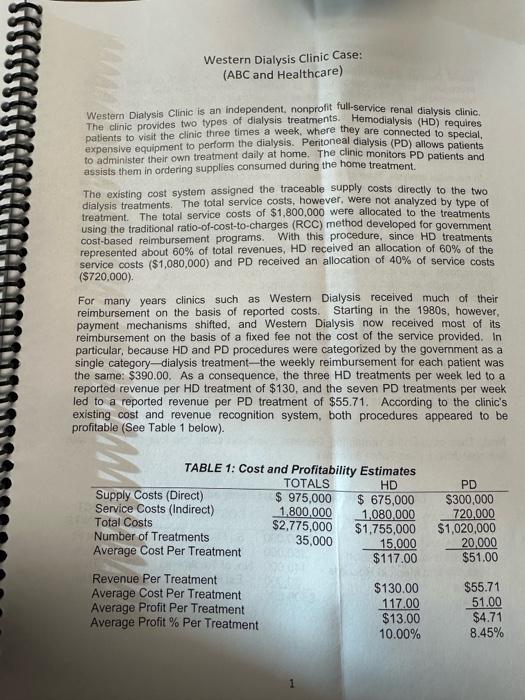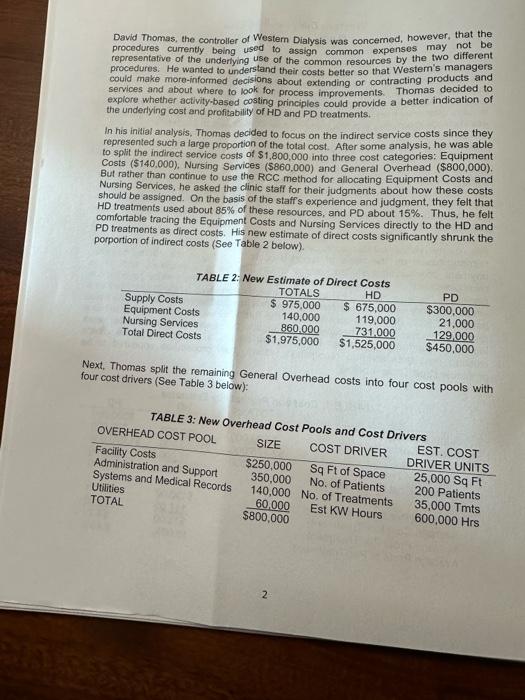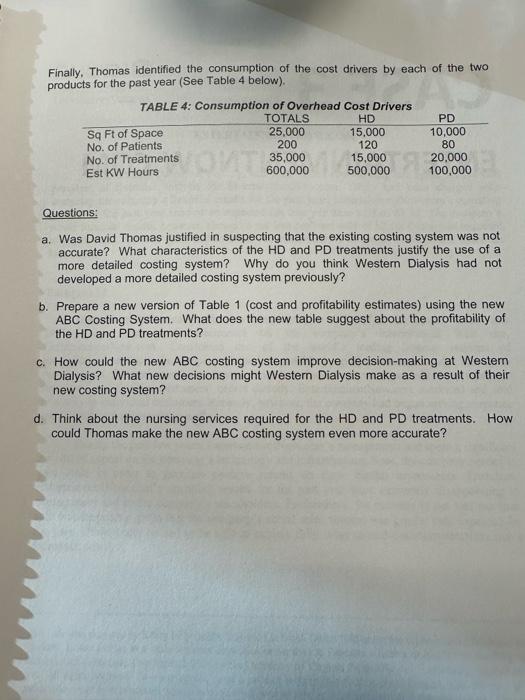Answered step by step
Verified Expert Solution
Question
1 Approved Answer
Managerial accounting ( ABC and Healthcare) Western Dialysis Clinic is an independent, nonprofit full-service renal dialysis clinic. The clinic provides two types of dialysis treatments.
Managerial accounting 



( ABC and Healthcare) Western Dialysis Clinic is an independent, nonprofit full-service renal dialysis clinic. The clinic provides two types of dialysis treatments. Hemodialysis (HD) requires patients to visit the clinic three times a week, where they are connected to spectal, expensive equipment to perform the dialysis. Peritoneal dialysis (PD) allows patients to administer their own treatment daily at home. The clinic monitors PD patients and assists them in ordering supplies consumed during the home treatment. The existing cost system assigned the traceable supply costs directly to the two dialysis treatments. The total service costs, however, were not analyzed by type of treatment. The total service costs of $1,800,000 were allocated to the treatments using the traditional ratio-of-cost-to-charges (RCC) method developed for government cost-based reimbursement programs. With this procedure, since HD treatments represented about 60% of total revenues, HD received an allocation of 60% of the service costs ($1,080,000) and PD received an allocation of 40% of service costs ($720,000). For many years clinics such as Westem Dialysis received much of their reimbursement on the basis of reported costs. Starting in the 1980s, however, payment mechanisms shifted, and Western Dialysis now received most of its reimbursement on the basis of a fixed fee not the cost of the service provided. In particular, because HD and PD procedures were categorized by the government as a single category-dialysis treatment-the weekly reimbursement for each patient was the same: $390.00. As a consequence, the three HD treatments per week led to a reported revenue per HD treatment of $130, and the seven PD treatments per week led to a reported revenue per PD treatment of $55.71. According to the clinic's existing cost and revenue recognition system, both procedures appeared to be profitable (See Table 1 below). David Thomas, the controller of Western Dialysis was concemed, however, that the procedures currently being used to assign common expenses may not be representative of the underlying use of the common resources by the two different procedures. He wanted to understand their costs better so that Western's managers could make more-informed decisions about extending or contracting products and services and about where to look for process improvements. Thomas decided to explore whether activity-based costing principles could provide a better indication of the underlying cost and profitability of HD and PD treatments. In his initial analysis, Thomas decided to focus on the indirect service costs since they represented such a large proportion of the total cost. After some analysis, he was able to split the indirect service costs of $1,800,000 into three cost categories: Equipment Costs ($140,000). Nursing Services ($860,000) and General Overhead ( $800,000). But rather than continue to use the RCC method for allocating Equipment Costs and Nursing Services, he asked the clinic staff for their judgments about how these costs should be assigned. On the basis of the staff's experience and judgment, they felt that HD treatments used about 85% of these resources, and PD about 15%. Thus, he felt comfortable tracing the Equipment Costs and Nursing Services directly to the HD and PD treatments as direct costs. His new estimate of direct costs significantly shrunk the porportion of indirect costs (See Table 2 below). Next, Thomas split the remaining General Overhead costs into four cost pools with four cost drivers (See Table 3 below): David Thomas, the controller of Western Dialysis was concerned, however, that the procedures currently beling used to assign common expenses may not be representative of the underlying use of the common resources by the two different procedures. He wanted to understand their costs better so that Westem's managers could make more-informed decisions about extending or contracting products and services and about where to look for process improvements. Thomas decided to explore whether activity-based costing principles could provide a better indication of the underlying cost and profitability of HD and PD treatments. In his incial analysis, Thomas decided to focus on the indirect service costs since they represented such a large proportion of the total cost. After some analysis, he was able to split the indirect service costs of $1,800,000 into three cost categories: Equipment Costs ($140,000). Nursing Services ($860,000) and General Overhead ( $800,000). But rather than continue to use the RCC method for allocating Equipment Costs and Nursing Services, he asked the clinic staff for their judgments about how these costs should be assigned. On the basis of the staff's experience and judgment, they felt that HD treatments used about 85% of these resources, and PD about 15%. Thus, he felt comfortable tracing the Equipment Costs and Nursing Services directly to the HD and PD treatments as direct costs. His new estimate of direct costs significantly shrunk the porportion of indirect costs (See Table 2 below). Next, Thomas split the remaining General Overhead costs into four cost pools with four cost drivers (See Table 3 below): Finally, Thomas identified the consumption of the cost drivers by each of the two products for the past year (See Table 4 below). Questions: a. Was David Thomas justified in suspecting that the existing costing system was not accurate? What characteristics of the HD and PD treatments justify the use of a more detailed costing system? Why do you think Western Dialysis had not developed a more detailed costing system previously? b. Prepare a new version of Table 1 (cost and profitability estimates) using the new ABC Costing System. What does the new table suggest about the profitability of the HD and PD treatments? c. How could the new ABC costing system improve decision-making at Westem Dialysis? What new decisions might Western Dialysis make as a result of their new costing system? d. Think about the nursing services required for the HD and PD treatments. How could Thomas make the new ABC costing system even more accurate 



Step by Step Solution
There are 3 Steps involved in it
Step: 1

Get Instant Access to Expert-Tailored Solutions
See step-by-step solutions with expert insights and AI powered tools for academic success
Step: 2

Step: 3

Ace Your Homework with AI
Get the answers you need in no time with our AI-driven, step-by-step assistance
Get Started


